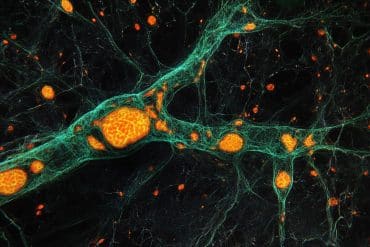Summary: Targeting synaptic calcium permeable receptors in the nucleus accumbens and blocking them could delay or prevent the onset of Alzheimer’s associated neuropsychiatric symptoms, and ultimately cognitive decline.
Source: Indiana University
Researchers from Indiana University School of Medicine are studying why neuropsychiatric symptoms, such as apathy and irritability, appear in most Alzheimer’s disease patients before the onset of memory loss.
The study, led by Yao-Ying Ma, MD, Ph.D., assistant professor of pharmacology and toxicology, was recently featured in the publication Molecular Psychiatry.
The team of researchers identified a receptor in the brain that leads to a loss of neurons and synaptic structure when used in an Alzheimer’s disease model.
The investigation focused on the nucleus accumbens, a critical brain region processing motivation. Located in the ventral striatum, this region is not studied much among Alzheimer’s disease researchers, Ma said; it’s mainly researched to understand motivational and emotional processes. Previous studies, Ma said, have shown that the volume of nucleus accumbens, like the cortical and hippocampal regions in the brain, is reduced in adults with Alzheimer’s disease.
Ma, who is relatively new to the field of Alzheimer’s disease research, has a background in drug addiction studies and synaptic communication—the process by which neurons talk to each other in the brain. Some of the neuropsychiatric symptoms among people who suffer from substance abuse—apathy, mood swings, anxiety—are also found in Alzheimer’s disease patients.
“Even before the onset of cognitive deficits, a significant number of Alzheimer’s patients start showing mood swings, and they have a greater chance to have symptoms of depression,” Ma said.
These neuropsychiatric symptoms, however, tend to occur earlier than memory loss, but no effective treatments are available, Ma said. She emphasized that there is an urgent need to understand why those symptoms exist and how they correlate with cognitive deficits.

Ma said this study identified synaptic calcium permeable receptors (CP-AMPARs) in the nucleus accumbens in an Alzheimer’s disease model. The receptor, which is normally absent in that part of the brain, gives permission for calcium to enter the neurons. This leads to an overload of calcium, which leads to a breakdown of its synaptic structure.
In turn, calcium accumulation triggers a cascade of intracellular changes that can be lethal to the neuron by amplifying calcium overload via a positive feedback mechanism.
This synaptic loss in the brain causes motivation deficits. Knowing this, Ma said that targeting these receptors in the brain and blocking them could prevent or delay the onset of Alzheimer’s disease associated neuropsychiatric symptoms, and ultimately cognitive deficits.
“If we can postpone the pathological progression in one of the affected areas, like the nucleus accumbens,” Ma said, “that may delay pathological changes in other regions.”
About this Alzheimer’s disease research news
Author: Press Office
Source: Indiana University
Contact: Press Office – Indiana University
Image: The image is in the public domain
Original Research: Open access.
“Amyloid-β oligomers in the nucleus accumbens decrease motivation via insertion of calcium-permeable AMPA receptors” by Changyong Guo et al. Molecular Psychiatry
Abstract
Amyloid-β oligomers in the nucleus accumbens decrease motivation via insertion of calcium-permeable AMPA receptors
It is essential to identify the neuronal mechanisms of Alzheimer’s Disease (AD)-associated neuropsychiatric symptoms, e.g., apathy, before improving the life quality of AD patients.
Here, we focused on the nucleus accumbens (NAc), a critical brain region processing motivation, also known to display AD-associated pathological changes in human cases.
We found that the synaptic calcium permeable (CP)-AMPA receptors (AMPARs), which are normally absent in the NAc, can be revealed by acute exposure to Aβ oligomers (AβOs), and play a critical role in the emergence of synaptic loss and motivation deficits. Blockade of NAc CP-AMPARs can effectively prevent AβO-induced downsizing and pruning of spines and silencing of excitatory synaptic transmission.
We conclude that AβO-triggered synaptic insertion of CP-AMPARs is a key mechanism mediating synaptic degeneration in AD, and preserving synaptic integrity may prevent or delay the onset of AD-associated psychiatric symptoms.







